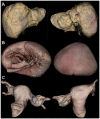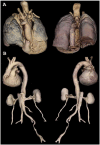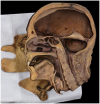Photogrammetry of Human Specimens: An Innovation in Anatomy Education
- PMID: 30246148
- PMCID: PMC6144583
- DOI: 10.1177/2382120518799356
Photogrammetry of Human Specimens: An Innovation in Anatomy Education
Abstract
Cadaver-based anatomical education is supplemented by a wide range of pedagogical tools-from artistic diagrams, to photographs and videos, to 3-dimensional (3D) models. However, many of these supplements either simplify the true anatomy or are limited in their use and distribution. Photogrammetry, which overlaps 2-dimensional (2D) photographs to create digital 3D models, addresses such shortcomings by creating interactive, authentic digital models of cadaveric specimens. In this exploratory pilot study, we used a photogrammetric setup and rendering software developed by an outside group to produce digital 3D models of 8 dissected specimens of regional anatomy. The photogrammetrically produced anatomical models authentically and precisely represented their original specimens. These interactive models were deemed accurate and teachable by faculty at the Stanford University Division of Clinical Anatomy. Photogrammetry is, according to these results, another possible method for rendering cadaveric materials into interactive 3D models, which can be used for anatomical education. These models are more detailed than many computer-generated versions and provide more visuospatial information than 2D images. Future researchers and educators could use such technology to create institutional libraries of digital 3D anatomy for medical education.
Keywords: 3D models; Medical education; anatomical models; anatomy education; digital anatomy; photogrammetry; prosections.
Conflict of interest statement
Declaration of conflicting interests:The author(s) declared the following potential conflicts of interest with respect to the research, authorship, and/or publication of this article: The authors of this study are all affiliates of the Stanford University Division of Clinical Anatomy, which collaborates with Anatomage, Inc. for medical education purposes only. Anatomage, Inc. may patent and profit from the described method in the future. None of the authors have any financial ties to Anatomage, Inc.
Figures




Similar articles
-
Foundations and guidelines for high-quality three-dimensional models using photogrammetry: A technical note on the future of neuroanatomy education.Anat Sci Educ. 2023 Sep-Oct;16(5):870-883. doi: 10.1002/ase.2274. Epub 2023 Apr 13. Anat Sci Educ. 2023. PMID: 36934316
-
Evaluating a Photogrammetry-Based Video for Undergraduate Anatomy Education.Adv Exp Med Biol. 2023;1421:63-78. doi: 10.1007/978-3-031-30379-1_4. Adv Exp Med Biol. 2023. PMID: 37524984
-
Digital preservation of anatomical variation: 3D-modeling of embalmed and plastinated cadaveric specimens using uCT and MRI.Ann Anat. 2017 Jan;209:69-75. doi: 10.1016/j.aanat.2016.09.010. Epub 2016 Oct 21. Ann Anat. 2017. PMID: 27777116
-
Use of photogrammetry-based digital models in anatomy education: An overview.Morphologie. 2024 Dec;108(363):100792. doi: 10.1016/j.morpho.2024.100792. Epub 2024 Jun 8. Morphologie. 2024. PMID: 38852514 Review.
-
Interactive 3D Digital Models for Anatomy and Medical Education.Adv Exp Med Biol. 2019;1138:1-16. doi: 10.1007/978-3-030-14227-8_1. Adv Exp Med Biol. 2019. PMID: 31313254 Review.
Cited by
-
A workflow for the creation of photorealistic 3D cadaveric models using photogrammetry.J Anat. 2023 Aug;243(2):319-333. doi: 10.1111/joa.13872. Epub 2023 Apr 7. J Anat. 2023. PMID: 37432760 Free PMC article.
-
Analysis of the Influence of the Geometrical Parameters of the Body Scanner on the Accuracy of Reconstruction of the Human Figure Using the Photogrammetry Technique.Sensors (Basel). 2022 Nov 25;22(23):9181. doi: 10.3390/s22239181. Sensors (Basel). 2022. PMID: 36501882 Free PMC article.
-
The Effectiveness of OsiriX and the Anatomage Virtual Dissection Table in Enhancing Neuroanatomy and Neuroradiology Teaching.Adv Med Educ Pract. 2023 Sep 22;14:1037-1043. doi: 10.2147/AMEP.S418576. eCollection 2023. Adv Med Educ Pract. 2023. PMID: 37772090 Free PMC article.
-
Facial Anatomy Teaching for Aesthetic Surgery: Using 3-dimensional Photogrammetry and Immersive Virtual Reality.Plast Reconstr Surg Glob Open. 2025 Jul 9;13(7):e6972. doi: 10.1097/GOX.0000000000006972. eCollection 2025 Jul. Plast Reconstr Surg Glob Open. 2025. PMID: 40642258 Free PMC article.
-
Using design thinking to create and implement a 3D digital library of anatomical specimens.Clin Anat. 2025 May;38(4):419-431. doi: 10.1002/ca.24198. Epub 2024 Jun 28. Clin Anat. 2025. PMID: 38938222 Free PMC article.
References
-
- Raja DS, Sultana B. Potential health hazards for students exposed to formaldehyde in the gross anatomy laboratory. J Environ Health. 2012;74:36–40. http://www.ncbi.nlm.nih.gov/pubmed/22329207. - PubMed
LinkOut - more resources
Full Text Sources
Other Literature Sources

